Beneficial Bugs
Design your gardens for pollinators and other allies
Photographs by the author
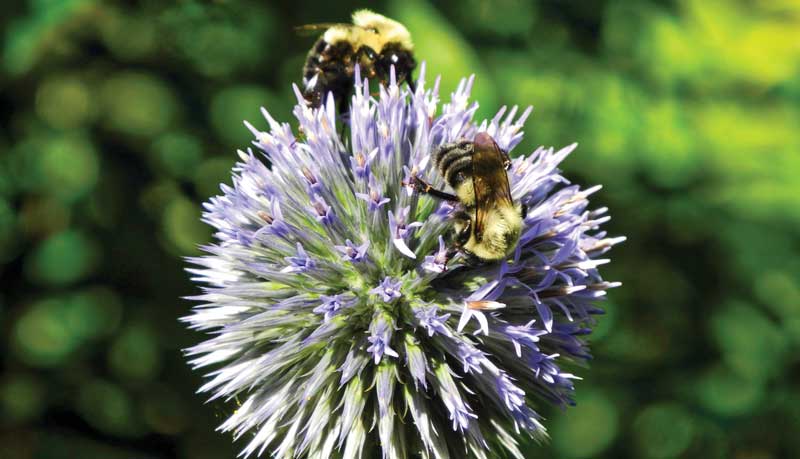 Planting for pollinators means planting flowering annuals, perennials like globe thistle (Echinops banaticus), blooming shrubs, and trees.
Planting for pollinators means planting flowering annuals, perennials like globe thistle (Echinops banaticus), blooming shrubs, and trees.
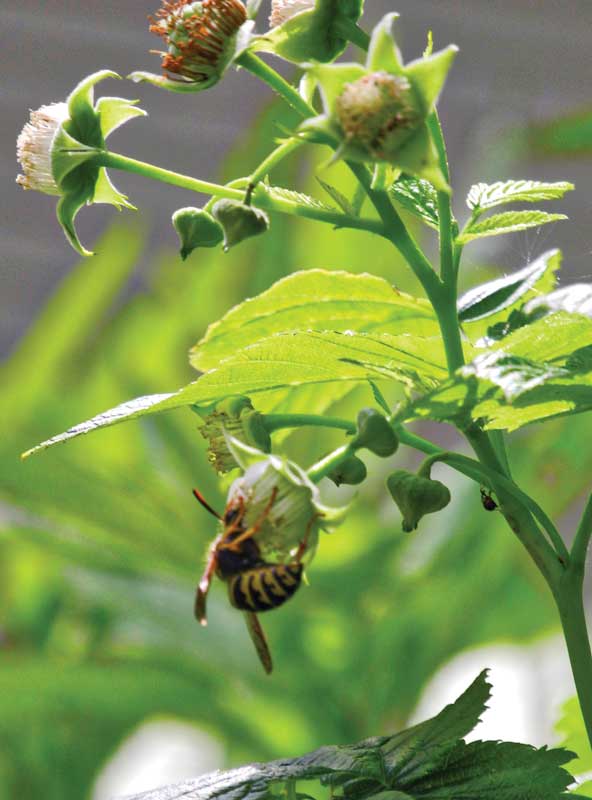 A tiny green wasp pollinates a mullein blossom.
When it comes to bugs—insects, if you prefer—few rate high on the “most popular” scale, if at all. Oh sure, we love to love ladybugs and butterflies. But for the most part, run-of-the-mill bugs like wasps, beetles, and flies are not considered beneficial.
A tiny green wasp pollinates a mullein blossom.
When it comes to bugs—insects, if you prefer—few rate high on the “most popular” scale, if at all. Oh sure, we love to love ladybugs and butterflies. But for the most part, run-of-the-mill bugs like wasps, beetles, and flies are not considered beneficial.
Stop here, and consider. What do we mean when we call an insect beneficial? Usually, it’s because we believe it does something for us; maybe it eats bugs we don’t like, or produces something we value, or does a job we value such as pollinating our crops. When you get right down to it, however, that dragonfly that gobbled the mosquito that was about to bite you, or the bees that labored to produce the honey you spread on your biscuits while at the same time pollinating the apple crop, they weren’t doing all that just for you.
Rather, those insects are programmed to do certain things, no matter what we think about them. And there are a lot of insects out there—a whole lot.
In numerical terms, of the 800,000 to 1,000,000 kinds of bugs we share the world with, some 97 percent are either beneficial to us or do not do us or our interests any harm. It turns out only one tenth of one percent can be considered actual pests. Not only that, they are all part of an intricate web, meaning that many insects depend on other insects for their survival.
Kind of makes one rethink the issue of insects, doesn’t it? When it comes to the insect world there is a complex web with more than a bit of overlap.
Types of insects include:
- Pollinators—wasps, flies, bees, bumblebees, butterflies, moths
- Predators—wasps, beetles, flies, dragonflies, spiders
- Parasitoids—wasps, flies
- Pretty—butterflies, ladybugs, dragonflies, moths
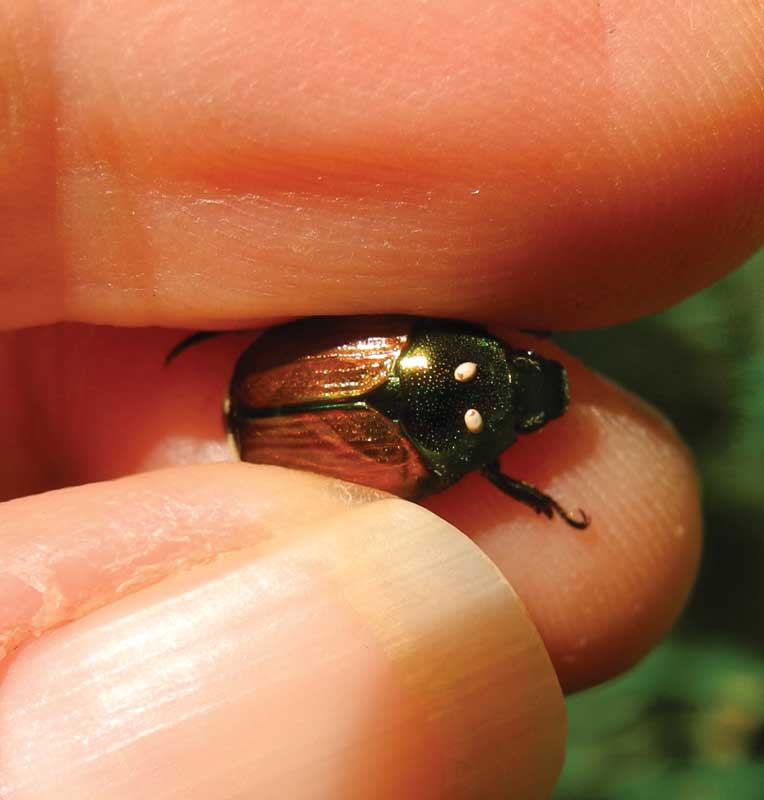 A Japanese beetle with parasitic tachnid eggs.
Honeybees are one of our major pollinator insects, and in many cases are vital for crop success. But they aren’t the only insects out there moving pollen around. Butterflies, flies, moths, native bees, bumble bees, and wasps are also pollinators. Spend a few minutes observing a bunch of blooms and prepare to be amazed at how many insects show up for lunch. Add a number of birds, like hummingbirds, for example, into the pollinator mix, and you’ve got a lot of support out there.
A Japanese beetle with parasitic tachnid eggs.
Honeybees are one of our major pollinator insects, and in many cases are vital for crop success. But they aren’t the only insects out there moving pollen around. Butterflies, flies, moths, native bees, bumble bees, and wasps are also pollinators. Spend a few minutes observing a bunch of blooms and prepare to be amazed at how many insects show up for lunch. Add a number of birds, like hummingbirds, for example, into the pollinator mix, and you’ve got a lot of support out there.
Gardens and insects and birds are interdependent. No bugs, no birds. And that is an important issue for gardeners. It represents a part of the big picture that is playing out in our landscapes.
The predator insects make a meal of other insects. Take ladybugs, which gorge on aphids, or those dragonflies that munch on mosquitoes, or spiders that suck the life out of other insects that eat our plants. (Spiders, though not technically insects, are also important predators.)
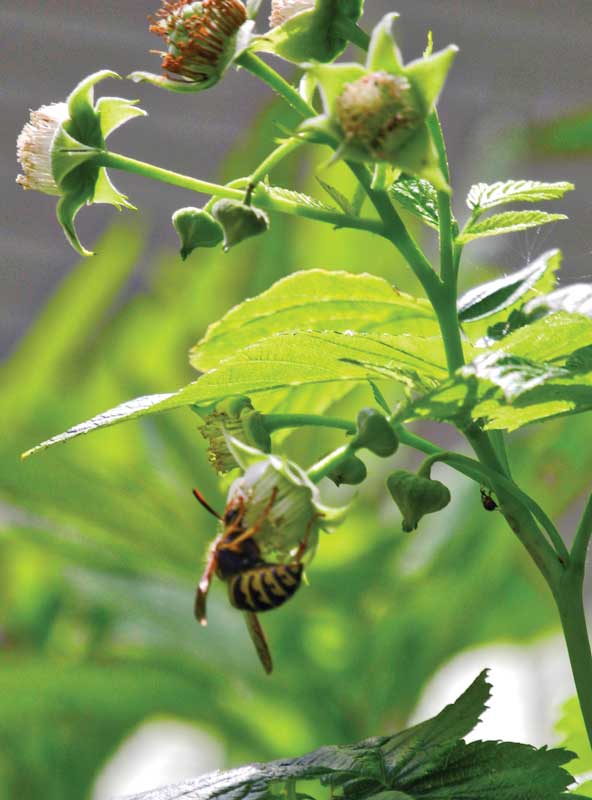 A small wasp busily pollinates raspberry plants.
The parasitoids are a breed apart in that their life cycles rely on the life cycles of other insects. There are parasitoid wasps and flies that lay their eggs on insects that eat our plants, insects like tomato hornworms or Japanese beetles. Many of those parasite insects also serve as pollinators. But when their eggs hatch, they consume the host bug from the inside out in a grisly fashion worthy of any horror movie. That’s good, too.
A small wasp busily pollinates raspberry plants.
The parasitoids are a breed apart in that their life cycles rely on the life cycles of other insects. There are parasitoid wasps and flies that lay their eggs on insects that eat our plants, insects like tomato hornworms or Japanese beetles. Many of those parasite insects also serve as pollinators. But when their eggs hatch, they consume the host bug from the inside out in a grisly fashion worthy of any horror movie. That’s good, too.
And then there are the pretty ones—the ladybugs, the butterflies, the luna moths, and so on. Some of them have decidedly beneficial habits. The point here is that there are thousands of insects and birds that depend on those insects, and most are doing things that benefit us and our gardens.
We have long been led to believe that bugs are bad, and that it is easy to simply spray away those pests we don’t like with chemicals. But when we spread insecticides or have our lawns treated, we not only disrupt a cycle of life involving all those insects and pollinating birds, we kill more good bugs than bad ones. Plus, the result often is a bounce-back of the “bad” bugs, without those good bugs that helped keep the bad ones under control.
And now we’ve got a mystery on our hands. Honeybees, native bees and some wasps, and even butterflies like the migrating monarchs are disappearing. Fingers point to habitat loss and chemical controls as culprits.
Aside from the beauty and wonder these marvelous insects provide, they are an important link in the food chain.
One of the solutions to the mystery of pollinator decline is to provide food and habitat with blooming plants. Another is to eschew chemical controls—both pesticides and herbicides.
This isn’t to say that we should not pick off those ghastly green worms on the tomato plants. But take a moment to see if there are some white rice grain-like nodules on the larvae. These are the eggs of a parasitoid insect, which will hatch into many more parasitoid insects, which will eat the tomato worm and ultimately many more of them, too.
And how do we attract the pollinators? That’s the easy part. Just plant flowering plants, shrubs, and trees.
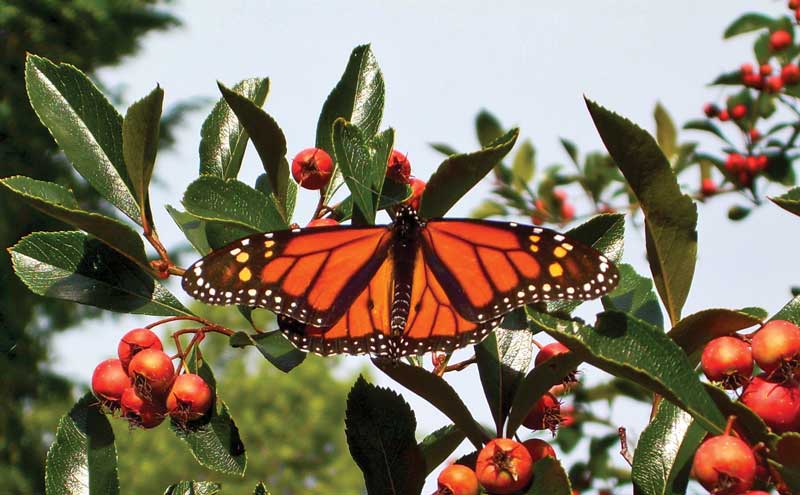 The colorful “fruits” of this mountain ash are a stunning match for a Monarch butterfly. Planting a variety of flowering trees, shrubs, perennials, and annuals attracts these and other valuable pollinators.
The colorful “fruits” of this mountain ash are a stunning match for a Monarch butterfly. Planting a variety of flowering trees, shrubs, perennials, and annuals attracts these and other valuable pollinators.
We don’t have to be entomologists, but the more we know about the many insects, their life cycles, and what they do for us, the more we understand and appreciate their importance in our lives and in the success of our gardens.
Imagine, solving a vexing environmental problem with flowers! It has to be one of the loveliest solutions ever. So nix those pesticides and herbicides. Just plant flowers, and waltz through the coming months surrounded by blossoms. That should be enough to make any gardener happy.
Lynette L. Walther is the recipient of the 2017 Garden Writers Association’s Award of Achievement, the second time she’s received this recognition. She gardens in Camden.
Related Articles
Share this article:
2023 Maine Boat & Home Show

Join Us for the Maine Boat & Home Show!
Art, Artisans, Food, Fun & Boats, Boats, Boats
August 11 - 13, 2023 | On the waterfront, Rockland, Maine
Click here to pre-order your tickets.
Show is produced by Maine Boats, Homes & Harbors magazine.















